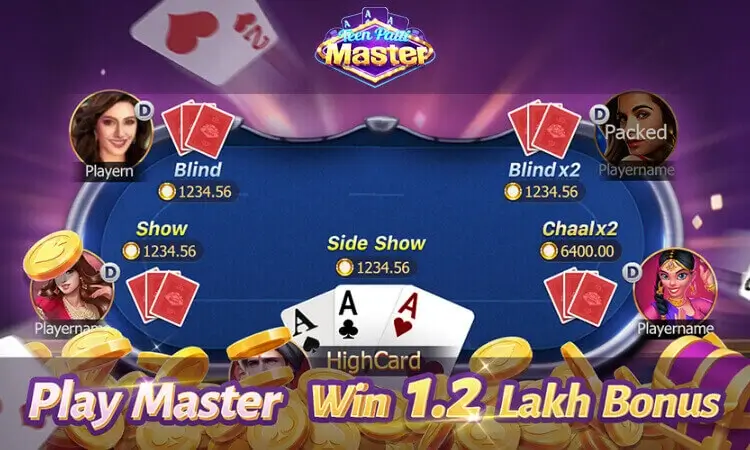Essential Strategies for Securing Success in Teen Patti Master

"Mastering Teen Patti: Key Methods for Superior Play '' provides a comprehensive collection of tactics pivotal for excelling in Teen Patti Master. It begins with the cautious strategy of initiating with modest wagers to minimise potential losses and extend game time. The guide highlights the tactical advantage of playing blind to execute clever bluffs, as well as the importance of honing the ability to analyse opponents, which is vital for making informed decisions during the game.
The text underscores the importance of effective bankroll management, recognizing the right moments to fold, and identifying the optimal time to switch from blind to seen play to better evaluate your hand. Additionally, it addresses the calculated use of sideshows, assessing pot odds for more intelligent betting, and underscores the critical need for flexibility within the game to adapt to its changing nature and the diverse strategies of other players.
Navigating Teen Patti Mastery
Let's delve into each of these Teen Patti strategies and explore their significance:
Ante Up: Initiating with Conservative Stakes
Here's a concise guide on starting Teen Patti with low stakes:
- Set Limits: Decide on a small starting bet based on a fixed amount or a small percentage of your chips.
- Start Blind: Begin by playing blind to bet the minimum, preserving your stack.
- Observe Opponents: Use initial hands to study your opponents' behaviors and tendencies.
- Maintain Discipline: Stick to your low-stakes strategy, resisting the urge to match high bets unless confident.
- Incremental Raises: If raising, do so gradually to avoid pot inflation.
- Manage Stack Growth: Adjust bets slowly as your chip stack increases, keeping them reasonable.
- Adapt Dynamically: Be ready to tweak your strategy with table changes while staying conservative.
- Control the Pot: Aim to keep the pot size manageable, avoiding large commitments with average hands.
- Focus on Sustained Play: Small bets allow more hands and opportunities to learn and adapt.
This conservative betting approach helps extend gameplay and is ideal for new players or those cautious of high stakes.
The Blind Gambit: Leveraging the Unknown
Playing blind in Teen Patti is a bold strategy with unique advantages:
- Stake Strategy: Bet lower as a blind player, based on predetermined rules.
- Psychological Edge: Playing blind can intimidate opponents, potentially causing those with better hands to fold due to the uncertainty of your hand.
- Game Pace: Blind play can keep stakes low and slow down the betting rounds, which can be beneficial against cautious players.
- Switching to Seen: You can choose to look at your cards anytime, but then you must bet like a seen player.
- No Sideshows: Blind players can't initiate or accept sideshows (comparing hands with another player).
- Winning the Pot: If all others fold, you win by default. In a showdown, you must reveal your cards to determine the winner.
Using the blind play is about embracing risk and using the mystery of your hand to control the game's dynamic.
Opponent Analysis: Unraveling Betting Tells
Here's a brief guide to reading your opponents in Teen Patti:
- Betting Patterns: Notice if a player consistently bets big or small; this can indicate their confidence level.
- Physical Cues: Watch for changes in body language or facial expressions that might reveal a player's nervousness or confidence.
- Reaction to Bets: Pay attention to how players react to others' bets—a quick fold or raise can signal their hand's strength.
- Playing Styles: Identify if players are aggressive, cautious, or unpredictable. Aggressive players may bluff more, while cautious players may bet high only with strong hands.
- Talk at the Table: Be aware of how players use conversation; talkative players might be distracting or bluffing.
By observing these aspects, you can better understand your opponents' strategies and adapt your play for a better chance of winning.
The Art of Bluff: Ploys and Feints
Mastering bluffing in Teen Patti requires subtlety and timing:
- Confident Bets: Bet with confidence; any hesitation can reveal a weak hand.
- Timing: Bluff when the game flow allows, ideally when your conservative play has set the stage for a believable bluff.
- Gradual Bets: Increase your bets smoothly, as erratic betting can signal a bluff.
- Solid Reputation: Build a reputation for playing tight; your bluffs will carry more weight.
- Choose Targets: Bluff against players who are more likely to fold under pressure.
- Positioning: Use a late betting position to your advantage, giving you more information before you act.
- Manage Stakes: Bluff with smaller pots where players may be less willing to call.
- Bluff Sparingly: Bluff infrequently to maintain the element of surprise.
Bluff wisely to turn the tables in your favor, turning bluffing into an art that can sway the game.
Chip Management: The Stack Equation
Effective chip management is essential for Teen Patti:
- Financial Limits: Set a clear maximum bet limit before playing and stick to it, avoiding any impact on essential funds.
- Smart Buy-Ins: Use only 5-10% of your bankroll for buy-ins to protect against major losses.
- Betting According to Bankroll: Adjust your bet sizes based on your available funds to prolong game play.
- Emotion Check: Pause if emotions start dictating your bets, particularly after losses, to prevent further damage.
- Profit Goals: Have a profit target for each session and quit when you reach it to lock in earnings.
- Track Finances: Keep a record of wins and losses to monitor your financial status and adjust play style as needed.
- Stakes Adjustment: Move to lower stakes if you're consistently losing, to preserve your bankroll.
- Discipline: Avoid the temptation to recoup losses quickly; stick to your management plan.
Adhering to these guidelines will help you manage your chips effectively, ensuring that Teen Patti remains an enjoyable and financially responsible activity.
Fold Strategy: Reading the Table
Cultivating the art of the fold is vital for bankroll longevity in Teen Patti. Here’s how to finesse your folding game:
- Weak Hands: Fold early when your hand holds little promise.
- Surging Bets: If bets soar and your hand is average, bow out to avoid bigger losses.
- Opponent Cues: Aggressive betting from others may hint at their strong hands. If yours doesn't measure up, folding is smart.
- Position Play: Early position with a weak hand often warrants a fold, especially if action follows.
- Bankroll Check: If calling puts your bankroll at risk, it's time to fold.
- Game Flow: A tight table with a high bet usually means strength; don't hesitate to fold.
- Chase Avoidance: Abandon the chase for the right card; more often than not, it's time to fold.
- Bet Dispassion: Don't let previous bets anchor you. Fold to save for future rounds.
- Strategic Vision: Folding is a long-term strategy for survival and success.
In essence, a well-timed fold is a strategic retreat that can lead to future victories.
Transition Tactics: From Blind to Chaal
Here’s a streamlined approach for deciding when to transition from blind to Chaal in Teen Patti:
- Pot Size: See your cards when the pot becomes substantial to inform your betting on a stronger basis.
- Opponent Behavior: If others are betting aggressively as Chaal, it might be time to check your hand.
- Bankroll Consideration: Ensure your funds can handle the higher Chaal bets.
- Table Position: Use a later position to your advantage for more insight into when to transition.
- Duration of Play: If you've been playing blind for several hands, consider seeing your cards to make more calculated bets.
- Reading Opponents: Look for cues from other players to determine if seeing your cards will provide an advantage.
- Game Dynamics: In a strong Chaal-dominated game, switch to seen to avoid blind competition.
- Pot Odds: Transition if the potential winnings justify the increased betting cost of Chaal.
Switching from blind to Chaal should be a thoughtful choice to maintain strategic leverage in the game.
Showdown Dynamics: The Sideshows
In Teen Patti, sideshows are a tactical feature used to compare hands under certain conditions:
- Eligibility: Only seen players who have bet can request a sideshow.
- Request: Ask the last betting player for a sideshow through a verbal or agreed-upon gesture.
- Consent: The challenged player may accept or decline. A decline forces you to bet or fold.
- Comparison: If agreed, both players quietly compare hands to determine whose is stronger.
- Outcome: The player with the weaker hand folds. In a tie, the requester folds.
- Discretion: Keep the hand comparison private.
- Continuation: The game moves on after the sideshow resolution.
- Limits: Be aware of any game rules that restrict sideshow frequency or increase cost.
- Strategic Use: Employ sideshows judiciously to assess opponents without inflating the pot.
Use sideshows strategically to gain insights while managing your risk.

Calculating Chaal: Understanding Pot Odds
In Teen Patti, gauging the pot odds is crucial for making calculated betting decisions:
- Compute Pot Odds: Pot odds are found by dividing the pot size by the call amount: Pot Odds = Pot Size / Call Amount.
- Evaluate Your Hand: Determine if your hand is strong, mediocre, or weak. This will guide your decision-making process.
- Weigh Against Hand Odds: Consider the likelihood that your hand is the best. Pot odds should be favorable relative to these odds to justify a call.
- Decision Making: Call if pot odds exceed your hand odds, suggesting a value bet. Fold if pot odds are insufficient to justify the risk.
For instance, with a $100 pot and a $10 call, your pot odds are 10 to 1. If your chance of having the top hand exceeds these odds, calling is a sound decision.
In Teen Patti, pot odds are less about precision and more about weighing potential gains against risks, aiding you in calling, raising, or folding decisions.
Adaptive Play: Shifting Gears Mid-Game
In Teen Patti, adaptability is key:
- Strategy Shifts: Change your playstyle when your current strategy isn't working. If aggression isn't paying off, consider a more conservative approach.
- Read the Room: Watch for patterns in your opponents' behavior and adjust your moves accordingly. Counter frequent bluffers by calling more often.
- Manage Variance: Stay composed during streaks of bad luck and adjust bets to keep your head in the game without tilting.
- Bankroll Tactics: If losing, reduce stakes or pause to avoid chasing losses.
- Table Dynamics: Adapt to the table's mood. If players are cautious, play more hands; if they're loose, tighten up.
- Adjust to Progression: As blinds and antes increase, revise your strategy to align with the rising stakes.
Simply put, successful Teen Patti players are those who adapt quickly to the game's dynamics, switching strategies as needed to gain the upper hand.
Closing Play: Summing Up the Winning Edge
Securing victory in Teen Patti Master hinges on a player's mastery of game mechanics, sharpened skills in discerning opponent behavior, judicious bankroll management, and the savvy to toggle between aggression and caution as the game dictates. Consistent practice, flexibility in adjusting to different game styles, and strategic employment of bonuses are pivotal. Marrying these tactics with astute awareness and emotional control sets the stage for a formidable presence at the card table.




